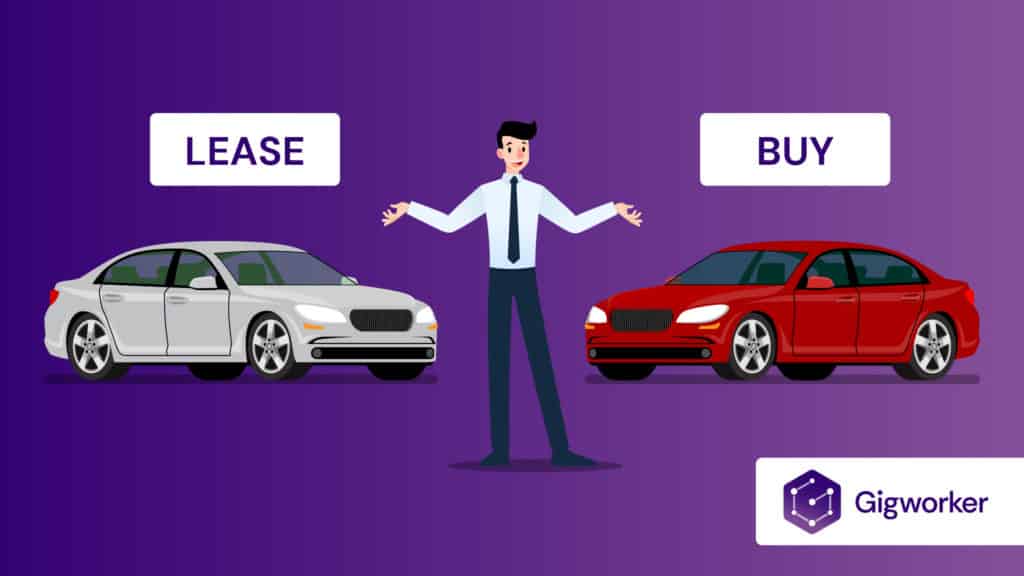If you’re considering becoming a driver for Uber or Lyft and you don’t already own a car, you’ll soon be faced with the question of whether you should buy, rent or lease a car for the job.
- Which option is best?
- Which option is the best value?
- Which option should I choose?
In this post we’ll make it easy to know which option to pick by outlining the most important takeaways that you need to know.
Let’s jump right in.
Limitations to Renting, Leasing, and Purchasing
Before you sign a contract to rent, lease or finance a vehicle for rideshare driving, make sure the contract allows you to use the vehicle for commercial purposes.
Standard leasing, rental and financing contracts typically don’t allow for any commercial activities whatsoever, so making sure you can use the vehicle for those purposes is incredibly important.
eep in mind that even if you take out a loan to purchase a car, you’ll still need to read the fine print.
Like the restrictions applied to leased and rented vehicles, most standard consumer car loans don’t allow the cars to be used in the conduct of commercial activities.
ever, is that plenty of new companies catering specifically to the rideshare market have sprung up recently.
Companies whose entire business model is centered around leasing and renting cars to rideshare drivers, as well as banks offering special loans, are also getting in on the action.
Some of these banks offer commercial car loans that do allow you to use your car Which Method is Most Expensive?
After looking at the options and crunching the numbers, we’ve concluded that you pay roughly the same no matter which method you choose.
The biggest difference is whether you’re paying the full price right now, or later as a deferred expense.
If you rent or lease a vehicle, the full price of the vehicle is a current expense that you’ll pay each week or month.
Your weekly and monthly costs will be much higher than they would be if you purchased a vehicle, but these expenses also don’t change and are super straightforward.
On the other hand, if you purchase a vehicle, a large portion of the full expense of the car is deferred until the day you decide to sell it.
That’s when the total depreciation expense that has accumulated on your vehicle will come due.
When you purchase a vehicle and earn money with it, you’re essentially taking out a “depreciation loan” against your car that will have one large payment that will come due on the day you sell the car.
Before that time comes, you’re able to live off of the money you earn, but you’ll pay a lot of it back in the form of having a less valuable car when it comes time to sell it or trade it in for a new car.
This means that on the day you sell your car, you’ll receive a good amount less for it than you would have had you not used it for rideshare driving.
That’s when the depreciation expense of the will become quite tangible.
Renting and Leasing Are a Lot More Expensive Each Week Than Owning
If you’ve looked at any of the rideshare rental or leasing plans, it may seem that they cost a lot more per week or month than purchasing a car.
It’s a little more expensive, but it’s not that much more when all is said and done.
The companies that rent or lease cars to rideshare drivers know on average how many miles rideshare drivers will put on their cars each week.
They therefore have priced it to take depreciation into account.
That’s the major reason the price seems higher.
Because you’re paying the depreciation cost each week, not just at the end of the rental or lease period.
Also, remember the leasing and rental companies are paying car registration and insurance expenses, in addition to most maintenance and repair bills.
Once you factor all that in with the depreciation cost, you’ll find that the difference in price is not all that great.
Which One Should I Choose?
If the costs are the same, which one should I choose?
Since the true cost of each method comes out pretty closely in the end, your choice then depends on your personal circumstances and preferences.
Upsides to Purchasing:
- Your immediate costs will be far less than either renting or leasing
- You don’t have to share the car with anyone else so you can keep it exactly the way you like it
- You can drive for all the companies – you won’t be restricted to just one – as you essentially are if you rent through Uber or Lyft.
Downsides of Purchasing:
- You’re responsible for all unexpected costs
- If your car is disabled for any reason, you can’t simply switch to another car
- You’ll think you’re making more than you are because the biggest expense – depreciation, won’t be due and payable until you sell the car
- It’s very difficult to get out of a purchase loan agreement if for any reason you should decide rideshare driving isn’t for you. You can sell the car of course, but most likely, you will get less for it than you still owe. You may have to come up with several thousand dollars out of pocket just to get rid of the car.
Renting vs. Leasing
The main difference between renting and leasing is that when you rent a car, you can generally turn the car in with nothing more than about a week’s notice.
The time in which you have the car is typically short.
This can be for as little as a few days, but usually not more than a week or two.
Many drivers rent a vehicle when their primary car is in the shop, or something comes up that hinders them from using their primary vehicle.
If you lease a car, you may be tied into it for two to three years.
If during that time, rideshare takes a nosedive and you find it hard to earn enough to pay for the car, you could be in trouble.
Or what happens if your rating goes too low and you’re cut off?
You’re still stuck footing the bill for a car you can no longer make money with.
In short, renting gives you the easiest ability to wash your hands and be done with the whole business.
Leasing usually comes with a longer-term commitment that’s not so easy to get out of.
And you may have to pay a substantial early termination fee if for some reason you have to cut your lease short.
Renting or Leasing Directly from Uber
Uber and Lyft both have various rental and leasing programs that vary by city.
Both companies have partnered with Hertz to offer rideshare drivers a rental option.
Uber recently partnered with Getaround in San Francisco to rent cars by the hour.
And for ridiculously low prices starting at $5 an hour!
That might be something to check out if you’re in San Francisco and if you’re a part-time driver.
Full-time drivers on this program would end up paying about the same as if they rented or leased a car.
If you’re a full-time driver then renting or leasing might be easier because you don’t have to turn the car in and get a new one each day as you do with Getaround.
It’s best, though, to check out their websites for your city to see what their current programs are because their programs are constantly changing.
Tips and Tricks on Buying, Renting or Leasing an Uber Car

- When buying, make sure to get the best auto loan rate. Do a thorough research on different auto-loan programs and take the time to compare each one. This will help lessen the total loanable amount if the deal is good.
- It’s important to understand Uber’s car requirements. They’re very strict with vehicle models. On top of that, they also require a mechanical inspection before getting approved.
- Considering the type of vehicle to purchase is also helpful. A cost-efficient, reliable car greatly reduces the driver’s fuel and maintenance costs.
- Choose a vehicle that satisfies a number of Uber services like UberX, UberXL, and UberSelect. These services differ in the number of passengers the vehicle can accommodate and quality of the ride. Catering to potential customers on different platforms allows the driver to make more money.
- Think carefully whether to buy a new or old vehicle for rideshare. You may not want to put thousands of passengers in your brand new car. On the other hand, other drivers have absorbed some of the depreciation of a used vehicle. Furthermore, old cars have lesser initial investment and still goes a long way capable of 4 to 5 years of service.
- When getting a lease or rental car for Uber, make sure to go for companies that offer Uber-accredited vehicles.
- Try checking Uber Vehicles Market. Uber created this platform to connect Uber partners looking for a driver or drivers looking for partners.
- Most lease companies require drivers to have insurance. Therefore, check the leasing company’s requirements first.
- For cheaper options, consider checking out peer-to-peer car service. These are vehicle marketplaces available today allowing drivers to connect with anyone interested in getting their car leased.
My Take
As you can see, there are both upsides and downsides to renting, leasing, or purchasing a vehicle for rideshare driving.
There really is no one recommendation, but instead evaluate your situation and then see which one is best for you.
What do you think of the vehicle options available to drivers? Let us know by dropping a comment below!






